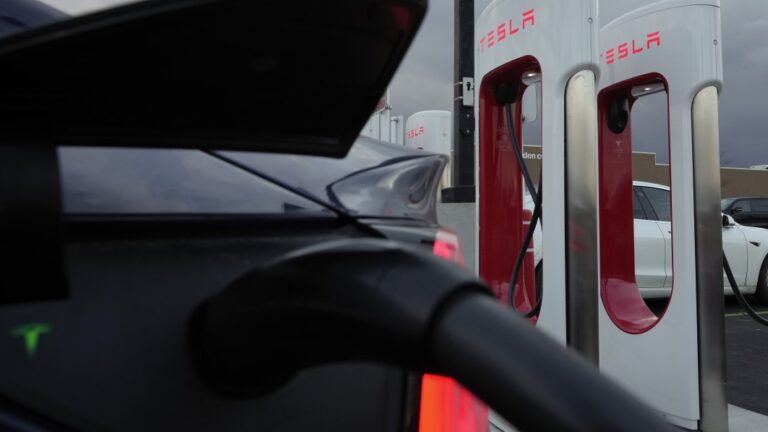Elon Musk’s decision to dismiss much of Tesla’s Supercharger team this week came as a shock. The move poses a particular threat to charging in the U.S. and the transition to electric vehicles in the region.
Rising competition, potentially unattractive profit margins and Musk’s focus on robotaxis all likely play a role in this bewildering story.
Tesla’s roughly 58,000 Superchargers have set the standard for EV drivers the world over. Musk’s decision to slow expansion will be felt most acutely in North America, where the network accounts for 74% of all ultra-fast chargers tracked by BloombergNEF.
The company has consistently installed more ultra-fast chargers in North America than all other networks combined. The first quarter of the year was no exception: Tesla installed a record 3,680 Superchargers, while its competitors collectively installed fewer than half that number.
Tesla’s imminent slowdown may put a damper on the region’s EV ambitions. BNEF forecast in its Long-Term Electric Vehicle Outlook that there needs to be around 400,000 ultra-fast chargers in North America to serve a fleet of 40 million battery-electric vehicles by 2030, and lay the foundation for over 90 million EVs just five years later.
Charging is a different story in Europe, where Tesla’s slowdown won’t be felt as strongly. A total of 390 companies added more than 13,000 ultra-fast chargers in the first quarter, which was 11 times greater than Tesla’s installations. Perhaps Musk is betting that the North American charging industry will look more like Europe’s in the years to come, and isn’t inclined to commit the capital required to keep growing the network at pace in an increasingly crowded market.
The CEO said two years ago that Tesla was aiming for a 10% profit margin from its network. BNEF estimated just last month that the company may have been on its way to $740 million in annual earnings from charging by 2030, or around 8% of company-wide profit last year.
Our analysis found that most listed charging companies have yet to achieve profitability, so another theory for why Musk is slowing Supercharger installations could be that his previously communicated target for profitability either was unattainable, or no longer was enough. Slowing Tesla’s rollout should increase utilization across the network, and we may even see a change in pricing strategy, which historically has undercut the competition.
Musk’s decision may also further demonstrate his devotion to making robotaxis a reality. On X this past weekend, he said Tesla will spend around $10 billion this year on “combined training and inference AI.” Assuming one can take that figure at face value — Musk’s social media posts aren’t always reliable — it means Musk intends for the company to devote almost all of this year’s capital expenditures to artificial intelligence. In a securities filing last month, Tesla said it expected more than $10 billion in capex this year.
“The way to think of Tesla is almost entirely in terms of solving autonomy and being able to turn on that autonomy for a gigantic fleet,” Musk said during the company’s April 23 earnings call. Later, he added: “If somebody doesn’t believe Tesla is going to solve autonomy, I think they should not be an investor in the company.”
For all the plaudits that Tesla’s Supercharger network deserves, the amount of money required to keep its extensive charging network up to date shouldn’t be underestimated.
Making its stations suitable for non-Tesla EVs likely will necessitate installing longer cables for bigger pickups and SUVs. And with almost every automaker slated to produce 800-volt EVs, more stations will require Tesla’s latest Version 4 hardware, which only makes up around 7% of its network currently. If Musk can realize his robotaxi vision, stations may also need to integrate wireless or robotic technology.
No matter what precipitated Musk’s moves, the dialing back of Tesla’s Supercharger ambitions adds to the already negative sentiment around EVs in the U.S.
Automakers have no time to feel sorry for themselves having been left in the lurch soon after switching to Tesla’s charging connector. The Ionna joint venture that seven automakers have set up to build at least 30,000 chargers needs to get off the starting blocks quickly.
And there are some reasons for optimism that new entrants can help fill the void, with more than 50 companies joining the sector after having won funding from the National Electric Vehicle Infrastructure (NEVI) Formula Program.
Even if there may be some merit to streamlining in the face of increasing competition and in order to focus on robotaxis, the chaos surrounding Tesla’s Supercharger operation is poised to ripple across the industry for months to come.


